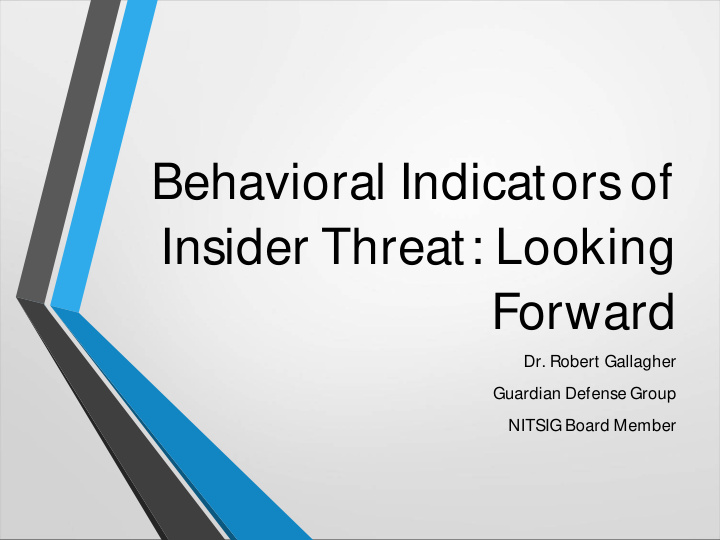



Behavioral Indicators of Insider Threat: Looking Forward Dr. Robert Gallagher Guardian Defense Group NITSIG Board Member
Insider Threat Indicator Lists • Everybody loves a list • If we had a single and comprehensive list of THE behavioral indicators of insider threat, all we would need to do is screen for or monitor those indicators and we could eliminate all insider threats • Everybody has a list • Cursory search turned up more than 20 distinct lists of behavioral indicators • Lists vary from a handful to hundreds of items
Three Primary Approaches to List Development • Reverse Engineering Cases • Study and identify precursors to action in known cases • Rational Approach – SME • Rely on logic and experience • Science • Those items that discriminate between good and bad actors
The Problem With Lists • Humans are Messy: • An indicator in one setting may not be an indicator in another • An indicator for one person may not be an indicator for another • An indicator for me one day may not be an indicator on another day • False Positives: • The base rate of insider threat is very small • For almost any indicator there will be more non-malicious actors doing it than malicious actors • General Flaws: • Reverse engineering of past events leads to a backwards orientation • Lists tend to treat all indicators as equally indicative • People tend to personalize and minimize selected items • Lists tend to reduce critical thinking
Alternate Approaches • Anomaly detection • Identify and assess any behavior that violates statistical norms • Cultural and contextual aberrance • Identify and assess any behaviors that violate the behavioral norms of the organization • Critical Pathway Modelling • Logical progression of risk from Precursors to full Insider Threat
The “Critical Path” to Insider Threat Risk: A Behavioral Model Sources: Shaw, E. and Sellers, L. (2015); Carnegie Mellon Univ. (2006-present) NOT EVERYONE WITH THESE Problematic Organizational Response: ISSUES is an Insider NOT Inattention Threat EVERYONE No risk assessment process WITH THESE Inadequate investigation ISSUES is an other actions escalate risk Insider Threat PERSONAL NOT EVERYONE PREDISPOSITIONS WITH THESE ISSUES is an M edical/ psychiatric Insider Threat conditions STRESSORS CONCERNING BEHAVIORS Affiliation risks INSIDER THREAT Attitudinal Challenges Interpersonal Personal LIKE BEHAVIORS Technical Malicious Acts Authority Problems Financial Financial Personnel Personality or social skill M ental health social network deficits Professional Suspicious travel Previous rule violations Decision making deficits
Case Example: Benedict Arnold Organizational Response Congressional censure Washington rebuke Court martial t Passed over for command Predispositions Billed for war debts Stressors Arrogant Imaginative Concerning Innovative Alcoholic father Behaviors Daring Crippling physical injuries Reckless Frequent duels War trauma Insider Threat Narcissistic Multiple resignations Professional reversals Entitled Circumvents Congress Espionage Personal losses Deifies orders Defection Overly Sensitive Family deaths Use position for personal gain Quick to anger Crushing debts Secret comms with enemy Quick to action Interpersonal conflicts Marries loyalist Financially driven Constant Disgruntlement Rule violator Saboteur Subversive Previous arrests Few Consequences Enemy affiliations
Conclusions • There is no single definitive list of behavioral indicators of insider threat (and perhaps there never should be) • Insider threat is a dynamic human problem and requires a dynamic human solution • Overreliance on lists of behavioral indicators may cause us to focus on the wrong behaviors, suspend critical thinking, or reach inaccurate conclusions • All concerning behaviors should be viewed within the individual, organizational and cultural context
Questions Dr. Robert Gallagher rgallagher@gdgllc.us 301-318-0245
Recommend
More recommend